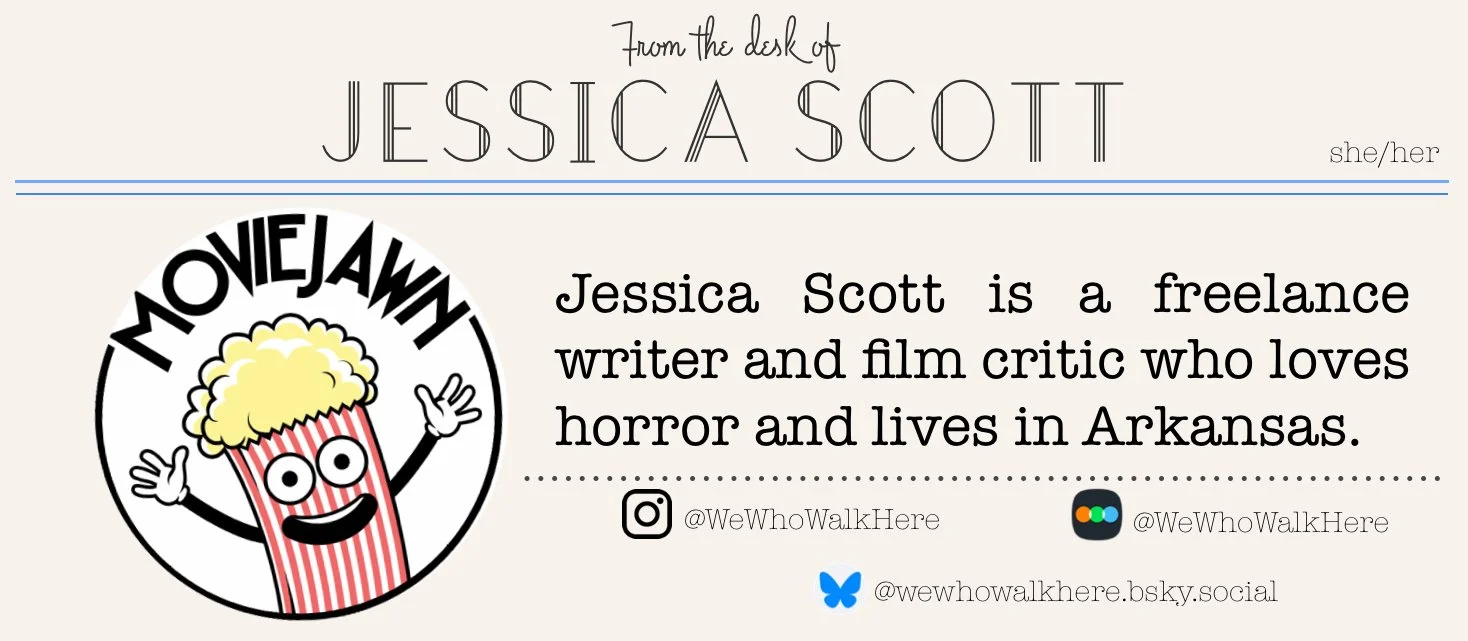Best of 2024: LONGLEGS gets horror right by doing everything wrong
by Jessica Scott, Staff Writer
There’s something wrong with Longlegs.
That’s entirely by design, of course. While Nicolas Cage has won justifiable acclaim for his brilliantly off-kilter performance as the titular Satanic serial killer, the film’s inescapable sense of wrongness comes primarily from its deliberately skewed framing. Writer-director Oz Perkins, director of photography Andrés Arochi, and production designer Danny Vermette throw out the rules that govern visual continuity and balance to create a world that is tilted subtly on its axis.
Each frame of the film deviates from cinematic conventions so diabolically that many viewers won’t be able to pinpoint why they feel on edge and unmoored. Characters look in ostensibly wrong directions during conversations; props and sets are off-center, both within the frame and in relation to each other. None of the film’s angles line up. That distortion extends to the camera itself: the aspect ratio changes frequently, keeping the viewer off-balance, while wide-angle lenses warp the frame’s edges, literally blurring reality. Frequent POV shots and grainy naturalism convince the viewer that this is the real world, but unexpected low angles and truncated framing call attention to the larger reality outside the frame. All these intentionally ill-fitting puzzle pieces join together to form a picture of the world that is far more terrifying and inexplicable than we want to believe it is.
The first two scenes of the film are perfect illustrations of its skewed worldview. We see Longlegs before the opening credits sequence, but we only see him from his nose to his hips; the film hides his full face for much of its runtime. He ducks down into the frame (bending his “long legs” to do so) to show a young girl a flash of his face in a pre-credits jump scare. It’s a fascinating combination of playful and terrifying.
Longlegs treats the frame as elastic and malleable, stretching its borders irregularly throughout the film as the aspect ratio pulses and sighs. By its nature, horror has always been more concerned than other genres with what lies beyond the boundaries of its frame — the monster lurking just out of sight, the killer slicing up victims in the house next door — but by calling attention to the frame by blatantly manipulating it, Longlegs makes the frame itself horrific. The boundaries of the frame represent our reality; they control what we can see and experience for ourselves. If those boundaries are mutable and subject to the whims of outside forces, then so too is reality. We can’t control the changing size or shape of our world, nor can we predict when or why those changes will occur. We can only watch it happen.
The scene immediately after the credits lies in stark contrast with the preceding scene. In the opening, Longlegs is outside in the snow; though the framing still makes the scene claustrophobic, bright whites and open spaces dominate. In the second scene, FBI agents crowd together in a dark room to discuss a serial killer they’re trying to catch. It’s a startlingly slanted tableau that becomes more distressing the longer you examine it. Every single element of the scene is visually out of balance. The agent leading the meeting is standing roughly in the center of the frame at a lectern; since he is speaking, the viewer’s eye naturally goes to him, but the lectern is slightly off-center. Just below the lectern is a patch of blood-red carpet, the sole spot of color in a sea of brown walls and black business suits. The viewer’s eye follows the red from the carpet to the red in the American flag that is too close to the center of the frame; from there, it goes to the leftmost fluorescent ceiling light. The lights are off-center, as are the two large windows on the wall facing the viewer. There are too many agents standing against the wall opposite the light that the viewer’s eye was just drawn to, and they are standing in the wrong positions within the frame. The composition is deliberately unbalanced and atonal.
Nothing in the film makes sense to the eye: the visual field is either too empty or too crowded; objects are either too close or too far. Things that would normally appear to be attempts at symmetry come close but don’t quite succeed. The visual dissonance is all the more maddening for its subtlety, like a tickle in your throat that never goes away…or a family secret that you can’t quite remember. Each frame in Longlegs becomes a cosmic referendum. There is an unequal sense of weight in each image, as if the screen will tilt like Anubis’s scale, and there is almost always far more light on one side than the other. Though the film only repeats itself when it wants to, it uses a variation of this motif in nearly every frame: darkness constantly encroaches from one side or the other, just waiting to swallow up the light at the opposite end.
Longlegs has few, if any, straight lines or right angles. Conversations lead the viewer to search the frame for an unseen third party as the eyelines of each shot-reverse shot triangulate a grounded surrealism. Once again, the paradox arises from the subtlety with which Perkins and Arochi break cinematic rules. When Agent Lee Harker (Maika Monroe) visits the significantly named Carrie Anne Camera (Kiernan Shipka) to see if she can provide a description of Longlegs, they sit and talk on couches in the lounge of the psychiatric facility where Carrie Anne lives. They never share the frame, and the angles of their faces don’t match up; based on what the viewer knows about the language of cinema, Carrie Anne and Lee don’t look like they’re facing each other as they talk. To underscore the wrongness of the exchange (and to emphasize the truth of Carrie Anne’s parting words to Lee), the angle on Lee’s face changes drastically on the dramatic penultimate shot of their conversation. This is the angle that makes sense and makes it look like they are talking to each other; the fact that the “correct” angle is so jarring and upsetting just confirms Longlegs’ exquisite control of cinematic wrongness.
Taken at face value, Longlegs is a procedural thriller (albeit one with a supernatural twist): FBI agents hunt down and capture a serial killer who is targeting families. By their nature, procedurals tend to be linear and logical: investigators ask whodunit, they find clues that lead them to further clues, and those clues lead them to the correct answer. Herein lies the problem: this formula assumes a linear, logical world where objectively correct answers exist. Longlegs shows us a world where nothing fits together perfectly. Truth, family, memory, self…these are not fixed words with steady definitions. They are shapeshifters; murky signifiers ready to change at a moment’s notice when someone or something stretches the frame of our respective reality. Nothing in Longlegs follows conventional visual vocabulary, and that sly refusal to adhere to accepted cinematic norms is what makes it the daring and frightening film its genius marketing campaign promised audiences. Longlegs has the best framing of 2024 because it invites viewers into a world they think they know and proves that the steady axis on which it supposedly spins was never anything but a puff of smoke.




